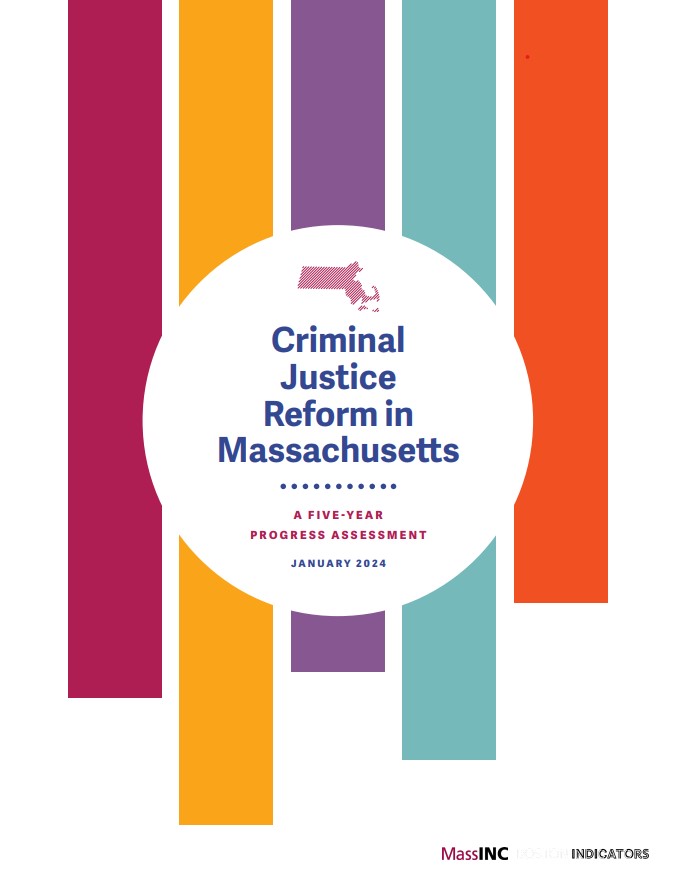New report highlights declines in Massachusetts crime and incarceration rates since 2018 criminal justice reforms
MassINC/Boston Indicators research suggests continued investment in reforms to continue improvements
January 24, 2024
Boston – Five years after Massachusetts passed landmark criminal justice reform legislation, a new report from MassINC and Boston Indicators finds Massachusetts has become a national leader in crime reduction.
The new report, Criminal Justice Reform in Massachusetts: A Five-Year Progress Assessment, finds that Massachusetts has seen incarceration fall by almost half in the past decade, with the sharpest reductions coming after 2018, while simultaneous investments in crime prevention, treatment, and reentry support likely contributed to a reduction in crime rates in Massachusetts, which largely avoided the major spikes in crime experienced in other cities and states during the pandemic.
“Overall, the story of criminal justice reform in Massachusetts since 2018 is largely positive,” said Lee Pelton, President and CEO of the Boston Foundation. “This research finds crime and incarceration have fallen, and we have significantly expanded services for many. Our challenge now is to continue with a focus on reducing the large racial and ethnic disparities in our prison populations with housing, treatment, and restorative justice practices.”
“Our research suggests that Massachusetts lawmakers’ decision to invest in community resources seems to be setting us apart when it comes to keeping both incarceration and crime relatively low,” said Ben Forman of MassINC. “But as communities work to overcome the stress of the pandemic, it is imperative that we find ways to continue to advance those investments.”
Positive momentum since 2010
While 2018 marked the passage of major reforms, efforts to address fairness and equity in criminal justice go back to 2010, when the state began to move away from “tough-on-crime” approaches beginning with legislation passed under Governor Deval Patrick in 2010. Those reforms set the stage for the 2018 reform laws, which included among other elements:
- Decriminalization of minor offenses;
- Expanded diversion provisions for juveniles and adults with behavioral health challenges;
- Reforms to pretrial detention;
- Sentence-length reductions for drug crimes (coupled with some sentence-length increases for opiates such as fentanyl);
- More stringent restrictive housing (solitary confinement) regulations;
- Provisions for medical release;
- Increased good time for program completion; and
- Improved data collection and transparency requirements.
Data analysis suggests that reforms have been a driving force in Massachusetts’ sharp declines in incarceration, which has fallen at more than twice the US average over the past decade, with outsized gains occurring since 2018. However, data don’t show progress yet in reducing racial and ethnic disparities in incarceration. Incarceration rates fell fastest among Whites and women, with some of the sharpest reductions also coming among younger “emerging adult” populations.
The report also notes a remarkable decline in convictions and sentences for drug-related offenses, with the number of person-years of incarceration for drug convictions falling by a third - although more research is needed to determine if case backlogs are contributing to the decline.
A shift in funds helping drive results
The report data also examines correctional spending since the passage of the 2018 laws – noting that while overall correctional spending has declined modestly relative to inflation, the reform laws have sparked tens of millions of dollars in investment in substance abuse treatment and other services, as well as in community economic development in high incarceration communities.
In addition, the report highlights a more than $30 million annual investment in reentry services, providing housing, education, job training and other supports to those exiting incarceration – a critical investment at a time when the region’s housing costs are among the highest in the nation. A new residential reentry line item supports transitional housing at locations in Boston, Springfield, New Bedford and Northampton. There has also been new funding for job training and additional resources for community-based organizations that provide both pre-release and post-release services.
The data show one major area of concern, however – efforts to expand treatment and other alternatives to incarceration are limited by a lack of access to inpatient treatment beds and supportive housing for those exiting inpatient treatment.
The reform laws also required better data collection and transparency, with an eye toward surfacing the root cause of racial disparities in incarceration. While some progress has been made, considerable work remains to understand how equitably and effectively the criminal justice system serves individuals from arrest to release.
Five recommendations for the future
The report concludes by highlighting five recommendations for a more effective, fair, and equitable criminal justice system in Massachusetts, all informed by the state’s successes since 2010. They include:
- Fully implement the data and transparency provisions of the 2018 reform law with a deeper commitment to evaluation and unearthing the root causes of racial disparities.
- Increase continuing care and community-based treatment capacity.
- Maintain investments in residential reentry and address unmet housing needs for emerging adults.
- Build sustainable capacity for community reinvestment and restorative justice.
- Prepare a correctional facilities master plan that confronts lingering issues that have major implications for criminal justice reform and public safety in the Commonwealth.
By taking action to address challenges such as the continued racial disparities in incarceration and the shortage of behavioral health resources, the authors see real opportunity for continued success. “Our efforts and investments to combat these challenges appear to be making a very real difference,” the report notes. “With fiscal pressures likely to be felt in the coming years, it is critical to document these returns and double down on success.”

